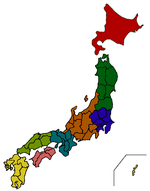Tsu Castle
Tsu Castle (津城, Tsu-jō) was a Japanese castle located in Tsu, Mie Prefecture, Japan. During the Edo period, Tsu Castle was home to the Sudo clan, daimyō of Tsu Domain, who dominated the provinces of Ise and Iga. The castle was also known as "Anotsu-jō" (安濃津城) after the ancient name for Tsu. The castle ruins are a Prefectural Historic Site.
| Tsu Castle 津城 | |
|---|---|
| Tsu, Mie Prefecture, Japan | |
 Reconstructed Yagura of Tsu Castle | |
 Tsu Castle from the air | |
| Coordinates | |
| Type | flatland-style Japanese castle |
| Site information | |
| Condition | Reconstructed 1958 |
| Site history | |
| Built | 1558, major reconstruction in 1608 |
| Built by | Hosono Fujiatsu Tōdō Takatora |
| In use | Sengoku period-1889 |
History
During the Sengoku period, in 1558 Hosono Fujiatsu built a castle at the conjunction of the Ano and Iwata rivers, using the rivers as natural moats. Oda Nobunaga took control of the castle in 1568 and ordered his younger brother Oda Nobukane to reside there in 1577 to consolidate Oda control over the Ise region. Under Oda Nobukane, the castle was greatly expanded in size, with the completion of the primary, secondary and third baileys, a five-story donjon and secondary donjon. Under Toyotomi Hideyoshi, Nobukane was transferred to Tanba Province, and the castle was given to Hideyoshi’s retainer, Tomita Nobuhiro in 1595 along with a 50,000 koku domain.
However, during the Battle of Sekigahara in 1600, the Tomita clan sided with the eastern forces under Tokugawa Ieyasu and Tsu Castle was attacked by the western armies under Mōri Terumoto and Chōsokabe Morichika. Although the 1300 defenders put up a stiff defense, the 30,000 attackers largely burned the castle down around them. The Tomita were rewarded for their loyalty by the Tokugawa shogunate and were given an increase in revenue and rebuilt parts of the castle by the time they were transferred to Uwajima Domain in Iyo Province in 1608.
The Tomita were replaced by the Tōdō clan, who ruled as daimyōs over the 220,000 koku Tsu Domain until the Meiji Restoration. Tōdō Takatora, who was a noted castle architect, renovated Tsu Castle with a three-story and a two-story donjon and rejuvenated the castle town, and increased the clan’s revenues to 323,000 koku.
After the donjon was destroyed in a fire in 1662, the Tokugawa shogunate did not grant permission for it to be rebuilt, and it was replaced by a two-story yagura.
The castle was once ownd by Imperial Japanese Army. It was demilitarized and sold to former lord Tōdō Takakiyo in 1889. During Meiji period, most of its remaining structures were destroyed, except for a portion of its moats and two gates. The castle site became a city park. One corner yagura was reconstructed in 1958. However, it is not a historically accurate reconstruction, and contains various features copied from other structures to make it more visually appealing.
The Castle was listed as one of the Continued Top 100 Japanese Castles in 2017.[1]
Literature
- Schmorleitz, Morton S. (1974). Castles in Japan. Tokyo: Charles E. Tuttle Co. pp. 144–145. ISBN 0-8048-1102-4.
- Motoo, Hinago (1986). Japanese Castles. Tokyo: Kodansha. p. 200 pages. ISBN 0-87011-766-1.
- Mitchelhill, Jennifer (2004). Castles of the Samurai: Power and Beauty. Tokyo: Kodansha. p. 112 pages. ISBN 4-7700-2954-3.
- Turnbull, Stephen (2003). Japanese Castles 1540–1640. Osprey Publishing. p. 64 pages. ISBN 1-84176-429-9.
References
- "続日本100名城" (in Japanese). 日本城郭協会. Retrieved 25 July 2019.
External links
| Wikimedia Commons has media related to Tsu Castle. |
